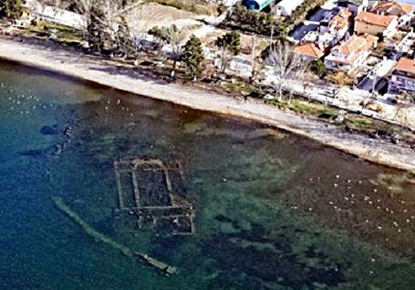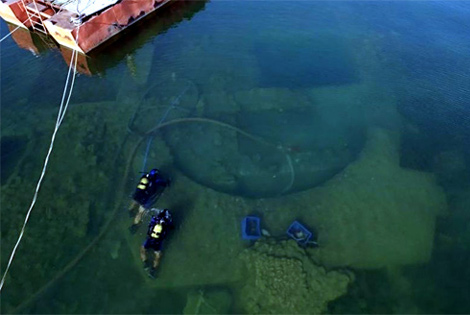The First Council of Nicaea, organized by Emperor Constantine in 325, was held in the town it took its name from, Nicaea. At that time part of the Roman Empire, the location in modern day Turkey is now called Iznik. Recently, evidence of the 4th century Christian presence in that area was discovered – underwater ~
About two hours from Istanbul (itself once known as Constantinople), Iznik sits on the shore of a green lake of the same name. Back in 2014, government surveyors using drones captured photos of a strange structure sitting just below the lake’s murky surface. They showed these photos to Mustafa Sahin, head of archaeology at Bursa Uladag University, who quickly realized what he was looking at: a church.

But this wasn’t just any church. Historical records tell us it was built sometime in the fourth century, in honor of St. Neophytus, a sixteen-year-old Christian boy who was tortured to death there in the year 303, under the Emperor Diocletian.
The dedication of this church to a martyr was no accident. Just a few years prior to its construction, Emperor Constantine had issued the Edict of Milan, declaring an end to Roman persecution against Christians and setting the stage for the underground church to go public.Source: Breakpoint
Aerial photographs commissioned by the government of the Bursa Province in Turkey revealed the remarkable outline of a church submerged in Lake Iznik, near ancient Nicea. It is located in only 10 feet of water, about 160 feet from shore. Archaeologists believe the church may have been built on the site of the former Senate Palace, where the first Council of Nicea took place in 325 AD. Underwater excavations have revealed several graves dating to the fourth century underneath the basilica’s main wall which included coins dating to the reign of Emperor Valens (364-378 AD).
There is evidence that an earlier pagan temple to Apollo might lie beneath the church. Plans are being made for the construction of an underwater museum that would include a walkway over the submerged church and an underwater glass room in the nave of the basilica.Source: Associates for Biblical Research
Constantine, the first emperor to convert to Christianity arranged the council primarily to settle a critical dispute among the 4th century Christian community. The central issue under contention was the nature of the relationship between God the Father and God the Son. While the entire assembly agreed upon the divinity of Jesus Christ, a minority faction didn’t hold that the Father and Son were of the same substance; both truly God. With Constantine presiding over the assembly, the majority prevailed and the Nicene Creed was adopted.
In addition to the creedal decision – the first uniform Christian doctrine – Nicea was notable as the very first “ecumenical” council. A couple hundred bishops attended, representing the vast majority of the Christian world at that time.
~~~~~~~~~~~~~~~~~~
The Nicene Creed
I believe in one God, the Father Almighty, Maker of heaven and earth, and of all things visible and invisible.
And in one Lord Jesus Christ, the only-begotten Son of God, begotten of the Father before all worlds; God of God, Light of Light, very God of very God; begotten, not made, being of one substance with the Father, by whom all things were made.
Who, for us men and for our salvation, came down from heaven, and was incarnate by the Holy Spirit of the virgin Mary, and was made man; and was crucified also for us under Pontius Pilate; He suffered and was buried; and the third day He rose again, according to the Scriptures; and ascended into heaven, and sits on the right hand of the Father; and He shall come again, with glory, to judge the quick and the dead; whose kingdom shall have no end.
And I believe in the Holy Ghost, the Lord and Giver of Life; who proceeds from the Father and the Son; who with the Father and the Son together is worshipped and glorified; who spoke by the prophets.
And I believe in one holy catholic and apostolic Church. I acknowledge one baptism for the remission of sins; and I look for the resurrection of the dead, and the life of the world to come. Amen.
~~~~~~~~~~~~~~~~
Related:
Ancient Church Hidden in Turkish Lake. And a Pagan Temple May Lie Beneath It. ~ Live Science article explains the historical significance of the find
Associates for Biblical Research ~ Great site to learn about on all the latest archeological discoveries confirming Biblical history





